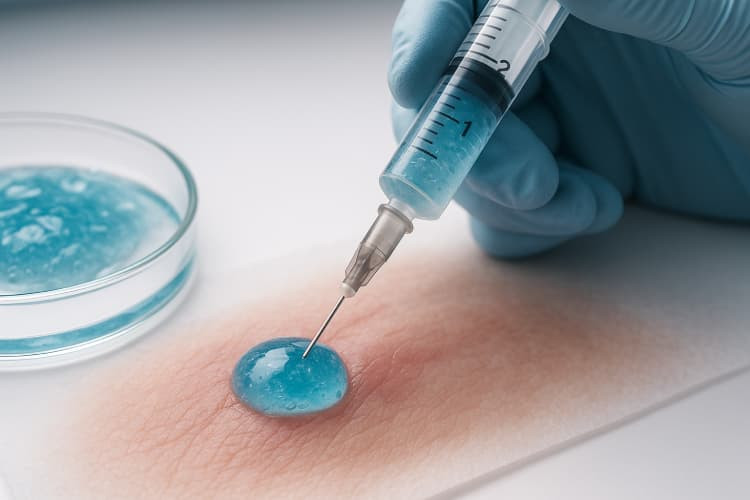Advances in Conductive Hydrogels for Bioelectronics
Technical Analysis | 07-08-2025 | By Liam Critchley

Key Things to Know:
- Injectable bioelectronics using hydrogels offer a biocompatible alternative to rigid implants but often suffer from low conductivity due to poor dispersibility of conductive materials.
- A new approach replaces traditional PSS dopants with sulphonated alginate (AlgS), improving PEDOT dispersibility by over 5× and conductivity by 20×.
- The PEDOT:AlgS formulation is biodegradable and supports real-time physiological monitoring and pH sensing in wound care applications.
- This innovation could pave the way for tunable, personalised bioelectronic systems with potential use in long-term health monitoring, wound healing, and neural interfacing.
Bioelectronics have become a key part of the healthcare sector and are playing an important role in medical diagnostics due to their ability to sense bio-signals. They are also used in advanced therapeutic strategies because they can stimulate damaged tissue to promote healing.
However, traditional medical implant devices require invasive surgeries, and in many cases, the solid and rigid devices used have problems interfacing with the soft tissue of the body. This leads to a mechanical mismatch between the device and tissues that can not only cause problems for the longevity of the device, but it can also cause localised inflammation and discomfort over time for the patient.
Soft and injectable bioelectronics based on hydrogels have emerged as a more biocompatible solution for medical devices, as they have a favourable tissue-interfacing ability through a closer tissue modulus match that enables them to integrate more seamlessly with the body. These are also less invasive than traditional approaches because they can be simply delivered using needles and catheters instead of invasive surgery. However, many bioelectronic systems suffer from a low electrical conductivity due to the poor dispersion of conductive additives within the hydrogel network.
Conductive Hydrogels and Injectable Platforms
Hydrogels are 3D crosslinked water-soluble polymers networks that retain water inside them without altering their structure. Hydrogels can contain conductive additive materials to make them conductive, but if they are not dispersed correctly, then those conductivity properties can become localised instead of being present throughout the whole system. However, hydrogels can be easily implemented in injectable platforms, so they are one of the most clinically feasible options.
Metals and carbon-based additives are the traditional conductive additive materials in many devices and could theoretically help to make hydrogels a lot more conductive. However, despite their excellent electrical conductivity, they are typically associated with an immunogenicity and cytotoxicity risk because injectable electronics bio-degrade after use. On the other hand, conductive polymers such as PEDOT are not as conductive as metals or carbon, but they are biocompatible and more tunable for creating different systems. However, efforts to use PEDOT: PSS (a common pairing that PEDOT has) have led to the PEDOT particles becoming aggregated in the hydrogel network, leading to poor conductivities below their theoretical limit.
If dispersed properly, the conductivity of PEDOT-based hydrogels could be suitable enough for bioelectronic applications. There have been many successful efforts created so far to make PEDOT hydrogels more conductive, but the methods used have made them unsuitable for use in injection methods. So, the two areas still need to be bridged to make hydrogel bioelectronics that have a high enough conductivity but can still be injected.
New Approach Makes Injectable Hydrogels More Conductive
Researchers have tried to bridge this gap by making PEDOT hydrogels more conductive while still retaining their ability to be injectable. To achieve this, the researchers used naturally occurring hydrophilic biomolecule dopants instead of using PSS to boost the dispersibility and conductivity of the PEDOT molecules in the hydrogel network.
Solving Dispersibility Challenges in PEDOT-Based Hydrogels
Hydrogel additives are freeze dried before being dispersed into the aqueous hydrogel system, however, it was found that the hydrophobic polystyrene backbone in PSS is the reason for the poor dispersibility of PEDOT:PSS in injectable hydrogels―because their hydrophobic nature would naturally want to aggregate with other hydrophobic particles to reduce the interfacial surface area with the water in the hydrogel. Instead of PSS, the researchers chose to use sulphonated alginate with the PEDOT (PEDOT:AlgS) due to its large number of polar groups and hydrophilic backbone. Using hydrophilic alternatives helped to increase the dispersibility of the conductive additive within the hydrogel by over 5 times compared to those with PEDOT:PSS (more than 20% w/v). The dispersion stability was also found to last over long time periods.
In addition to improving dispersibility, the sulphonated alginate dopant enabled the PEDOT particles to remain in a nanoscale dispersion, avoiding the macro-aggregates often seen in PEDOT:PSS systems. This finer distribution resulted in a significantly more uniform electrical pathway throughout the hydrogel matrix. According to Gao et al., PEDOT:AlgS achieved nanoparticle distributions under 100 nm, which contributed to both the improved conductivity and long-term colloidal stability in aqueous solutions—critical for maintaining performance post-injection.
The ability to disperse over five times the concentration of conductive additive compared to previous efforts led to a 20-fold increase in conductivity―a massive increase. The polymers used in the hydrogel are all biodegradable inside the body, so they are suitable for injectable bioelectronic applications, unlike other efforts to improve conductivity.
Importantly, the PEDOT:AlgS platform exhibited in vivo degradability due to the hydrolysable nature of the sulphonated alginate backbone. Over an 11-week implantation study, the PEDOT:AlgS matrix degraded progressively, with immune cells infiltrating the material—indicating natural tissue compatibility. This biodegradation mechanism supports clearance via renal excretion, making it suitable for transient biomedical devices that must dissolve after functional use.
The enhanced conductivity was validated through electrochemical impedance spectroscopy, which revealed lower percolation resistance and greater charge transfer capability in PEDOT:AlgS formulations. These systems intersected impedance curves at significantly lower Zreal values compared to PEDOT:PSS-based hydrogels, demonstrating improved charge mobility. The optimised percolation network enabled consistent conductivity even under physiological conditions.
Real-World Applications in Bioelectronic Systems
These PEDOT:AlgS additives are compatible with a range of hydrogel systems―including alginate and catechol-based bio-adhesive hydrogels―that are used in injectable bioelectronics systems. The researchers highlighted a couple of applications where these conductive additives can be used and have been trialled experimentally:
- For helping to form ionically cross-linkable conductive inks in 3D-printed alginate-based soft electrodes for monitoring devices that can measure physiological signals and temperature with a much higher sensitivity than PEDOT:PSS.
- In gelatine-based bio-adhesive hydrogels, to improve the conductivity of smart injectable sealants, leading to more sensitive soft electrodes. In practice, they have achieved a 250% improvement in sensitivity in pH sensing for chronic wound and infection monitoring.
Further testing on wound infection models confirmed that PEDOT:AlgS bioadhesives delivered a ~3× greater current change in response to infection compared to PEDOT:PSS, providing a stronger electrical signal during the onset of pH variations. These responsive properties were stable over a full week of exposure and demonstrated recoverable conductivity after antibiotic treatment, highlighting the platform’s robustness for continuous wound monitoring.
Doping conductive polymers with hydrophilic groups, such as AlgS, has a lot of potential for a range of injectable bioelectronic applications, as the dopants/hydrogel can be easily tailored to meet the needs of the application. PEDOT:AlgS is also a lot more versatile than PEDOT:PSS. The alginate derivatives in the additive induce stronger interactions with other ionically crosslinking hydrogel systems than PEDOT:PSS does, meaning it can potentially be used with more injectable hydrogel systems than PEDOT:PSS can. When combined with an excellent in vivo response, this new PEDOT combination is a feasible option for many injectable bioelectronic systems. It’s also thought that a range of other natural biomolecules could be used as dopants to improve the conductivity of polymer semiconductor materials for the design of an even wider range of bioactive electrodes that can be used in healthcare applications.
The study proposes that natural biopolymers with hydrophilic and negatively charged functional groups—such as alginate, carrageenan, and dextran—can be chemically modified to serve as effective dopants. This opens a pathway for creating bioelectrodes tailored to specific tissue environments or signal requirements by adjusting the dopant chemistry during polymer synthesis. Such modular design capabilities align with the trend toward personalised medicine and tunable implantable electronics.
However, despite the success of the study in developing biodegradable systems that have a higher conductivity and are injectable, the conductivity of hydrogel electrodes is still a lot lower than that of metallic electrodes. While hydrogels don’t suffer from the same integration, tissue mismatch and rejection issues of metallic electrodes, the work done in this space is not finished as even higher hydrogel conductivities and other active features―such as being able to deliver therapies and possess antimicrobial properties―could help to develop more complex injectable bioelectronic systems that can be used for long time periods in the body for long-term real-time health monitoring, wound monitoring and healing, and neural interfacing applications.
Reference:

